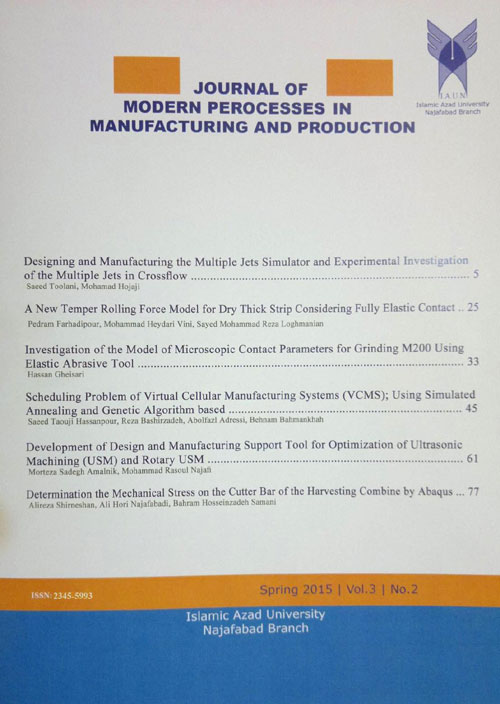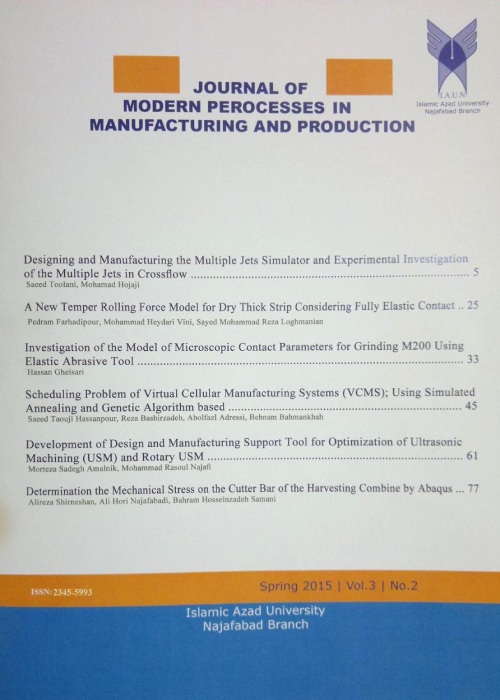فهرست مطالب

Journal of Modern Processes in Manufacturing and Production
Volume:9 Issue: 4, Autumn 2020
- تاریخ انتشار: 1400/02/13
- تعداد عناوین: 6
-
-
Pages 5-14The electric arc furnace (EAF) is one of the popular methods of steel production from steel scraps. The plasma arc is used in EAF to generate heat for melting scarp or direct reduced iron (DRI). The liquid metal is drained from the EAF through the tap hole. Nowadays, it is critical to use Automated/robotic tools for opening the tap hole with oxygen lancing. Because many workers have been blinded by spraying molten particles in opening operation. This study was aimed to simulate a robot manipulator with five degrees of freedom designed for opening the tap hole of an electrical arc furnace. The geometrical model of the robot was designed in Solid works software according to the real workplace and its expected path and obstacles. The Newton-Euler approach was employed to derive the dynamic equations and the resultant joint torques. The dynamic model is used to obtain the operating torques of the joints as well as in the simulation using the SimMechanic toolbox in Matlab software. The results of the simulation with SimMechanic show that the control system can follow the desired path of the robot with acceptable accuracy.Keywords: Electric Arc Furnace, Industrial Robot, Path planning, PID Control, SimMechanic
-
Pages 15-25
Deep drawing is a popular process in sheet metal forming. The goal of shape optimization of the initial blank which is considered in the present work is to find the shape of the blank in a manner in which after a deep drawing process the contour of the edges of the produced part meets a target contour. Such problems are highly nonlinear because the simulation consists of large deformation, plastic deformation, and contact. Therefore, the general approach to solving such problems is using iterative methods which are based on numerical simulation. Such an approach is also followed in the present work and a new algorithm for geometry modification of initial blank in each iteration is proposed. In the proposed algorithm, the normal distance between the final contour and target contour is used as a criterion to modify the initial blank. To evaluate the proposed algorithm a computer program is developed and to automatically execute the iterative process. One numerical example solved and the results are compared with those reported in the literature. One of the benefits of the proposed algorithm is its insensitivity to the initial guess. Therefore, to evaluate the effect of the initial guess on its performance the example was solved using different initial guesses. The results show that the proposed algorithm is robust regarding the initial guess and convergence to the optimum shape will be achieved by starting from an initial guess.
Keywords: Deep drawing, Shape Optimization, Blank Optimization, Finite Element Method -
Pages 27-37The facility layout problem (FLP) is a well-known optimization problem that seeks to arrange the layout of production units or facilities generally towards less cost and considering some adjacency factor between the facilities. The adjacency factor mainly represents the material handling costs. In this research, a novel multi-objective mixed integer nonlinear programming (MINLP) model for the single-floor facility layout problem is developed. The model, unlike the current literature, considers some maintenance measures in addition to the classical adjacency factor. Firstly, some facilities need a certain amount of maintenance space around them. If this space is violated, some penalty would apply. Secondly, some facilities could have emergency maintenance requirements for which easy access from the entrance edges is necessary. This accessibility measure is optimized in the model. The validity of the proposed MINLP model is analyzed via simulation. The results show that if material handling costs are minimized, the maintenance measures will deviate approximately 100% of their optimal values. Moreover, if maintenance measures are optimized, the material handling cost will deviate around 50% of its optimal value. Both, classic and maintenance related measures show more sensitivity in dense and crowded production environments.Keywords: Location, accessibility, MINLP, Multi-objective, Single-floor
-
Pages 39-45The increase in materials with high mechanical capabilities has increased the number of advanced production methods. One of these methods is the merging of ultrasonic vibrations with conventional machining methods. The milling process is flexible in making different geometric shapes of the workpiece. In this paper, the longitudinal vibrations assisted milling process is studied. The main problem with this process is the transmission of ultrasonic vibrations to the cutting area. Therefore, different transfer methods were studied and analyzed and the most efficient method was presented. Longitudinal vibration equations for the horn were analyzed and different types of horns were designed. The best horn was identified and fabricated in terms of increased vibration amplitude and less stress. It was shown that the 5-element horn is the best option for vibration transmission. In order to transfer electrical energy to the rotary ultrasonic converter, a new tool was designed and manufactured. By machining thin-walled parts, it was shown that the fabricated tool can create appropriate dimensional accuracy in the workpiece.Keywords: Longitudinal Vibrations, Ultrasonic, Milling
-
Pages 47-59
Today, metal forming is considered one of the essential methods of manufacturing and producing parts. Therefore, the more accurate knowledge of it leads the industrialists to produce higher quality parts. Deep drawing is one of the most important methods in metal forming processes used to produce cup-shaped products. In this paper, numerical simulation of the deep drawing process based on the finite element method is performed using Abaqus software for a cylindrical cup. Then, the results obtained from numerical simulation are compared with the experimental results in the sources, and the validation of the simulation is performed. In the deep drawing process, effective parameters such as circumferential strain distribution, thickness strain distribution, and radial force distribution are extracted from numerical simulations and compared with experimental results in the sources. The effect of friction coefficient, blank holder force, and punch radius on the deep drawing process has also been investigated. Because experimental methods based on trial and error are time-consuming and costly to achieve the shape of the primary blank, researchers use numerical methods to simulate and design metal sheet forming processes such as deep drawing. It is necessary to compare the results with experimental works to validate the simulations performed by numerical methods.
Keywords: Metal forming, Deep drawing, Finite Element Method, numerical simulation -
Pages 61-81The joining of dissimilar metals by Friction stir welding (FSW) is one of the newest metal joining processes. In this research, the tool was made from H13 hot working steel, which has a concave shoulder with a 3-degree inclined angle. The welding operation performed using a milling machine. The non-homogeneous workpieces joining of the Al alloy (5083) and a sheet of annealed copper (ASTM B36) with a thickness of 2 mm was investigated by the FSW method. The joining process was carried out at three tool transverse speeds of 25, 35, and 45 mm per minute and three rotational velocities of 1000, 1300, and 1600 rpm. Microstructural changes of the welded samples were analyzed by optical microscopy and scanning electron microscopy used to distinguish the type of phases. While its mechanical properties analyze according to different parameters used in the experiments. Also, the welded parts were subjected to microhardness and tensile tests. It found that the welding sample with a tool rotational speed of 1,300 rpm and a forward speed of 35 mm/min has the best mechanical properties, with a tensile strength of 82% and a yield strength of 80% of aluminum base metal. While welded components with a forward speed of 25 mm/min have tunnel defects and brittle phases of AlCu and Al2Cu formed in the stir region so that with the increase of rotational speed and forward speeds, the percentage of these brittle phases increases.Keywords: Non-homogeneous Metals, Friction Stir Welding (FSW), Aluminum Series 5xxx, Copper Alloy ASTM B36, Mechanical Properties


